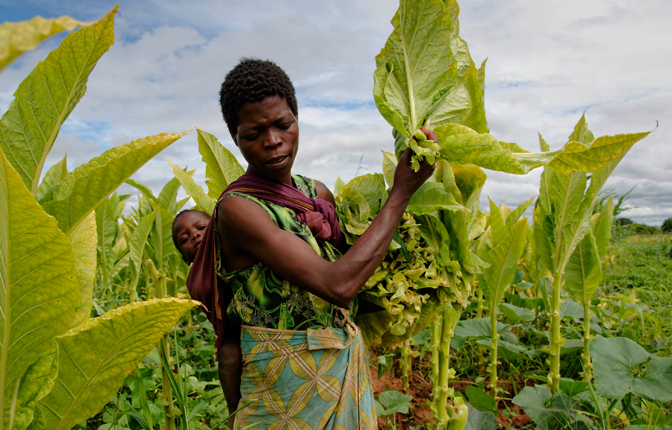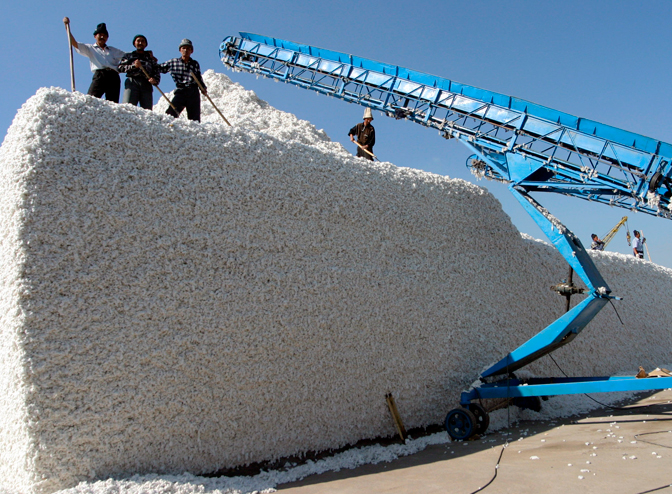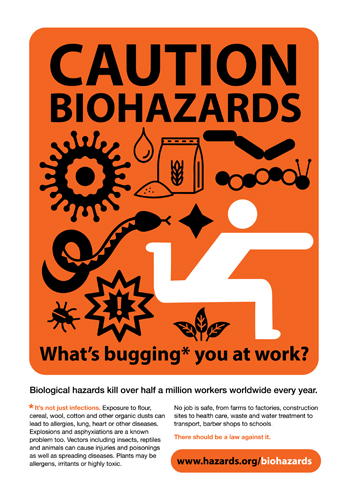Fonte Hazards.org ( Hazards, number 164, 2023 ) che ringraziamo
From natural fibres to furry critters, creepy crawlies to coronavirus, biological hazards in the workplace are a major and seriously under-estimated problem. Hazards editor Rory O’Neill says unions need to be vigilant for the infections, lung diseases, cancers and other related conditions that see half a million workers worldwide die each year.
Global estimates on biological risks at work, based on International Labour Organisation (ILO) data and published online in the journal Safety and Health at Work on 5 October 2023, identify a major problem that has remained under the occupational health radar.
Exposure to biological hazards at work accounted for over 550,000 deaths in 2021, the most recently reliable figures show, considerably higher than the annual toll from work-related fatalities. The new estimates indicate there has been an increase in disability adjusted life years (DALYs) attributable to biological exposures at work.
Related conditions included infectious diseases, restrictive and obstructive lung diseases, cancers, poisonings and injuries. Classic occupational diseases include cotton lung (byssinosis), farmers’ lung (fibrosing alveolitis) and bakers’ asthma.
Several occupational conditions, including cancers and lung diseases caused by biological exposures at work, are named explicitly in ILO’s List of Occupational Diseases (Recommendation 194). Hundreds of additional exposures to irritants, sensitisers, carcinogens and other hazards fall within the list’s qualifying terms for recognition as occupational diseases, causing conditions from asthma and cancer to anaphylaxis.
What’s the problem?
The ILO Technical Guidelines on biological hazards in the working environment agreed in 2022 and published in July 2023 established a broad definition of biological hazards at work. As well as the full spectrum of biological agents “and their associated allergens and toxins”, the guidelines specify the problem extends to “infectious and non-infectious diseases and injuries” and biological hazards from “vectors or transmitters of disease.”
INFECTIOUS PROBLEM? It’s more than infections that can bug us at work. Dusts, insects, rodents, reptiles and plants are among an extensive range of hazards that mean whatever your job, you may be exposed to biological hazards at work that can lead to diseases, disasters, outbreaks and injuries. More
Global unions had since 1993 called for an ILO Convention on biological hazards at work, but it was only in March 2021 that ILO’s governing body (GB) agreed a new standard on occupational health and safety protection against biological hazards would be negotiated at the ILO’s International Labour Conferences in 2024 and 2025.
The International Trade Union Confederation (ITUC), which will coordinate the union team in these negotiations, contends the new convention must reflect the broad scope established in the technical guidelines, and in addition to infectious and non-infectious diseases believes this standard must include poisonings, cancers and injuries – puncture wounds, cuts, abrasions, irritation and other harms related to the physical properties of biological agents and substances.
It should also cover explosions, asphyxiations or other physical risks related to the presence of the whole range of biological hazards in the work environment, and other conditions (sequela) arising out of exposures, including cardiovascular and psychosocial conditions.
Organic dusts like sugar and flour are an explosion risk; stored products can release gases or displace oxygen. And infections and occupational diseases can leave permanent reminders, like post viral fatigue, Long Covid or damage to heart valves.
Risks are present in all sectors, from infections and allergies in health, social care and service sectors workers, to infections, poisonings and other harms resulting from exposure to plants and vectors in construction, agriculture and waste, to emerging health issues in the biotech industry.
Vigilance is key. There is inevitably another ‘novel’ threat lurking. Covid-19 is a relative newbie, but it followed on from other workplace novel coronavirus outbreaks in the last two decades. SARS and MERS were far less transmissible but more deadly to those infected.
A systematised review of studies on biological hazards at work and their effects, published in the journal Safety and Health at Work on 5 October 2023, noted: “Biological hazards, both infectious and non-infectious, constitute significant threats to health in numerous industrial sectors and workplaces around the world, often leading to occupational and work-related diseases,” with relevant hazards including “infectious and non-infectious agents, endotoxins, bioaerosols, organic dust, and emerging agents.”
 TOXIC TOBACCO Workers handling tobacco leaves can develop severe nicotine poisoning. Green Tobacco Sickness sees workers suffering nausea and vomiting that can lead to hospitalisation. Affected workers are also at greater risk for heat-related illness – a potentially deadly condition. Hundreds of other plants can pose a risk to agriculture, horticulture and outdoor workers, including poison ivy, poison oak, poison sumac, giant hogweed, ragweed, foxglove and oleander.
TOXIC TOBACCO Workers handling tobacco leaves can develop severe nicotine poisoning. Green Tobacco Sickness sees workers suffering nausea and vomiting that can lead to hospitalisation. Affected workers are also at greater risk for heat-related illness – a potentially deadly condition. Hundreds of other plants can pose a risk to agriculture, horticulture and outdoor workers, including poison ivy, poison oak, poison sumac, giant hogweed, ragweed, foxglove and oleander.
The review added the risks are “very significant in many occupational activities, involving different modes of exposure and different health outcomes,” with further studies necessary “to combat all hazards to human health, including emerging ones.”
The growing public health threat from antimicrobial resistance (AMR) raises concerns that known risks can lead to new and more serious outcomes at work. This, and lessons learned from a succession of ‘novel’ coronavirus outbreaks impacting on workplaces – in sequence SARS, MERS and Covid-19 – demonstrate the need for vigilance, effective surveillance and a preventive, precautionary approach to risks, all factors that should be reflected in a new ILO standard.
Protect yourself
The Covid-19 pandemic demonstrated that to secure an effective public health response, with many health, food, transport, education and other workers deemed ‘essential’ so not able to stop work or work from home, occupational health and safety rights had to be supplemented by wider employee protections and support.
Income support and better, more comprehensive access to sick pay, available to all workers, was determined to be critical to limiting workplace infections and related transmission to the wider population. Low paid workers, particularly, need financial security to make sick leave an affordable option.
 COTTON PICKING BAD Cotton dust can cause the potentially fatal lung disease byssinosis, occupational asthma and respiratory irritation.
COTTON PICKING BAD Cotton dust can cause the potentially fatal lung disease byssinosis, occupational asthma and respiratory irritation.
Measures to prevent the cross over of animal diseases to humans – for example, recent interventions to prevent Avian Flu in poultry or mink farms, or BSE and TB in cattle – can involve culls and the temporary or permanent closure of businesses on public health grounds. Income support and employment protection measures are necessary to achieve effective implementation of related public health interventions.
Where the law falls short, your best protection is the union. Collective bargaining saves lives – official.
Mortality from Covid-19 in the US: Did unions save lives?, published by the ILO in November 2023, found union-negotiated safety measures during the pandemic led to reduced infection rates. It found a 10 per cent increase in unionisation was associated with an equivalent reduction in Covid-19 mortality, from 26 deaths per 100,000 workers to 24 per 100,000 workers.
US studies established union action reduced community Covid-19 infection rates through securing better reporting and better protective/preventive measures. Studies in nursing homes showed lower rates of both Covid-19 patient deaths and worker infections in unionised workplaces.
Key references
- Jukka Takala, Alexis Descatha, A. Oppliger, H. Hamzaoui, Catherine Bråkenhielm, Subas Neupane. Global estimates on biological risks at work, Safety and Health at Work, published online ahead of print, 5 October 2023.
- Alexis Descatha, Halim Hamzaoui, Jukka Takala, Anne Oppliger. A systematized overview of published reviews on biological hazards, occupational health, and safety, Safety and Health at Work, published online ahead of print, 5 October 2023.
- Technical guidelines on biological hazards in the working environment, ILO, July 2023.
- Mortality from Covid-19 in the US: Did unions save lives?, ILO, November 2023.
ITUC briefings
- Biological hazards and the work environment: Trade union position and priorities ahead of the International Labour Conference 2024 first discussion on occupational safety and health protection against biological hazards, ITUC, December 2023.
- Peligros biológicos y entorno laboral: Postura y prioridades de los sindicatos de cara al primer debate de la Conferencia Internacional del Trabajo 2024 sobre protección de la salud y la seguridad en el trabajo contra los peligros biológicos, CSI, Diciembre 2023.
- Risques biologiques et environnements professionnels: Position et priorités des syndicats en prévision de la première discussion de la Conférence internationale du Travail 2024 sur la protection de la sécurité et de la santé contre les risques biologiques sur les lieux de travail, CSI, Decembre 2023.
Resources
- Hazards infections webpage.
- Hazards coronavirus webpage.
- Antimicrobial Resistance (AMR) – A Workplace Hazard, IUF, 2018.
- Biological hazards, ILO Encyclopaedia of Occupational Safety and Health.
- Biological agents, US OSHA.
- HSE infections webpage.
- OSH Wiki: Biological agents.
- Work-related diseases from biological agents, European Agency for Safety and Health at Work (EU-OSHA).
- Biological agents and work-related diseases: results of a literature review, expert survey and analysis of monitoring systems, European Agency for Safety and Health at Work (EU-OSHA), November 2019.
- SARS – Practical and administrative responses to an infectious disease in the workplace, ILO, March 2004.
- Q fever website.
- World Health Organisation Zika factsheet.
- Ebola (Ebola Virus Disease): Information for healthcare workers, US CDC.
- Ebola Virus Disease: Occupational Safety and Health – joint WHO/ILO briefing note for workers and employers, 26 August 2014.

